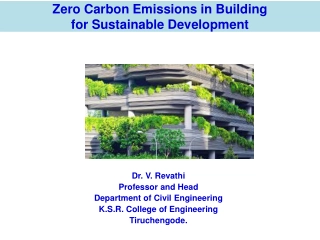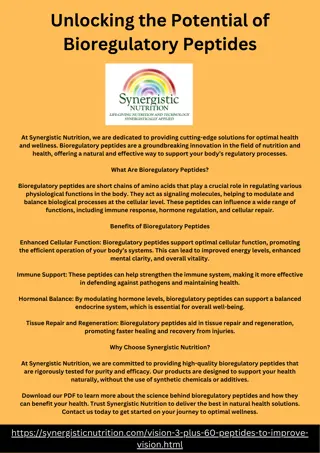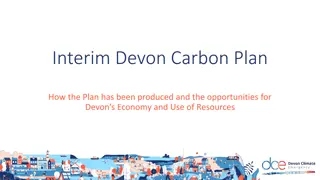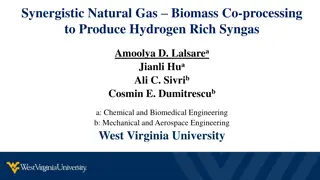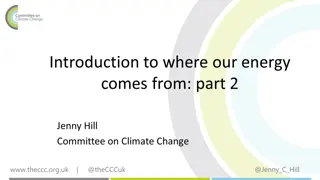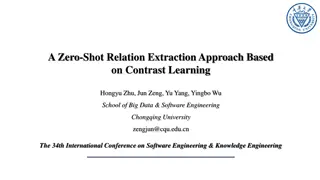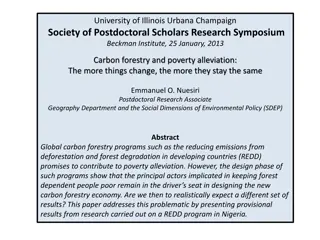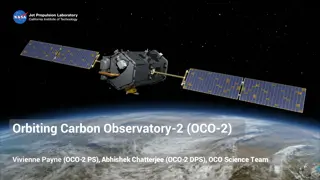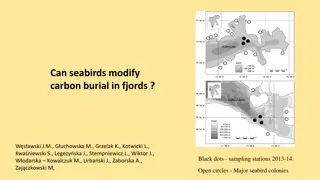Pathways to Building a Zero Carbon City-Region: Synergistic Collaboration & Learning
Explore synergistic pathways for collaboration and learning in building a zero carbon city-region. Topics include carbon mapping, integrated value-chains, and low carbon governance. Emphasize the importance of coordinated efforts among various stakeholders to achieve sustainable progress.
Download Presentation

Please find below an Image/Link to download the presentation.
The content on the website is provided AS IS for your information and personal use only. It may not be sold, licensed, or shared on other websites without obtaining consent from the author. Download presentation by click this link. If you encounter any issues during the download, it is possible that the publisher has removed the file from their server.
E N D
Presentation Transcript
Green Summit pre-workshop building a zero carbon city-region Synergistic pathways for collaboration & learning Synergistic pathways for collaboration & learning (work in progress on the GM Mini (work in progress on the GM Mini- -Lab) Lab) Questions: low carbon governance is firstly about Joe Ravetz Centre for Urban Resilience & Energy University of Manchester www.urban3.net
CARBON MAPPING: What - where who how when - how much?? Global atmospheric / oceanic carbon storage & climate system Alternative system boundaries: regional / urban / local Agriculture CO2 & other GHG Aviation CO2 & other radiative forcing CO2 sequestered in forestry, soil & land Energy conversion & distribution system Commercial in/direct CO2 & downstream climate responsibility Fossil fuel extraction & fugitive emissions Inbound marine shipping: direct & embodied CO2 Domestic building in/direct CO2 & supply chain Urban transport / infrastructure in/direct CO2 Outbound marine shipping: direct & embodied CO2 Industrial production & distribution in/direct CO2 Waste stream GHG & embodied CO2 emissions Fossil fuel reserves extracted Carbon capture & storage in fossil fuel formations Carbon long term storage in buildings, urban infrastructure, durable products.
INTEGRATED VALUE-CHAINS & SYNERGISTIC PATHWAYS We need to put together the many interests involved design and construction, finance and business, science and technology, communities and cultures, social innovation, and joined up governance. Progress on retrofit depends on the linkage between costs and benefits (many investments are difficult as the benefits are not easily returned (both direct savings & wider social / environmental values The cost-benefit balance is not only an abstract calculation: it s about the relations between different actors (stakeholders ): e.g. government, public services, businesses, property owners, builders, utilities, residents (owners or tenants), etc. schemes which looked good on paper, such as the Green Deal, failed (with some exceptions) in the real world. The synergistic approach starts with these relations. It looks for chains or loops of value-added (i.e. value-chains ) which depend on these relations and collaborations, between different parts of economy and society. Then it measures things which can be measured (e.g. money or CO2): and it evaluates things which are best evaluated (e.g. social well-being). A synergistic pathway is a set of coordinated value-chains , with a phased plan of action and collaboration. With this we can get beyond the usual barriers to progress (organization inertia, myopic business, split incentives etc).
LINEAR MODEL: GREEN DEAL 2013 SYNERGISTIC MODEL: GREEN DEAL-III (Thin lines show normal channels of market exchange) (Bold dashed lines show major gaps& barriers) Innovation / procurement / skills / local development pathway: combines public service with public benefit for workers & firms Technical- professional pathway: govt leads in raising skills, regulations, technical standards, with public housing as lead case COMBINED PATHWAYS COMBINED BARRIERS Collateral gap: asymmetric info & lack of trust = high finance & viability hurdles Split incentives: present owners / landlords won t invest if future owners / tenants benefit Inertia & uncertainty: firms & workers won t invest in technology & skills Finance / infrastructure / housing pathway: connecting owners, agents, utilities: integrated financial model Governance gap: collective action & coordination are difficult Social collateral & policy intel Disconnec- ted year zero policy Procurement for eco-inno- vation media & public sceptics Unstable & under- funded Positive media stories trusted inter- mediary role building health mentor role ACTORS & SYNERGIES Public housing in a mess Piecemeal design approach Civic & society Govern- ment Public service ACTORS & SYNDROMES Civic & society Govern- ment Public services Science / tech Science / tech Social / commun Public housing Private housing Social / commun Public housing Private housing Profes- sions Finance & devt Profes- sions Finance & devt Construc tion low take- up, frag- mentation Infra- structure Labour & skills Mutual finance investment & return community Construct ion Infra- structure Labour & skills Private HH inform- ation gaps & inertia High finance charges & costs Proxy markets / incentives for savings Skills gap, job insecurity Top-down, distrust, uncertain Re-socialize utility firms as mutuals Performance / skills incentive SMEs & workers builder role
EXAMPLE SERVICE MODEL / VALUE-CHAIN: KIRKLEES WARM ZONE Net benefit to NHS / public sector ACTOR MAPPING NHS Government Govt funds Agency Social Landlord NHS Public agency provides for tenants Tenant pays RSL Agency assists finance Social tenant RSL pays builders Finance Tenant pays utility Construction etc Energy Utility FACTOR COST-BENEFIT: CBA: owner + Fiscal + economic Energy running cost saving Takeup deadweight etc 625 / HH (5yr) Fiscal: ? 49M wider (5 yr) Social landlord finance Retrofit invest costs 21M total 425 / HH 6.2 pa total 125 pa / HH 24.5M health benefit (5 yr) FISCAL NHS savings HH personal health benefits ECONOMIC - Social valuation 126+116 jobs (5 yr) Webber, P., Gouldson, A. & Kerr, N. (2015). The impacts of household retrofit and domestic energy efficiency schemes: A large scale, ex post evaluation. Energy policy, 84, 35-43 Energy / CO2 benefits ECONOMIC: CO2 valuation 7.1M CO2 benefit (5yr)
MAPPING SYNERGISTIC VALUE-CHAINS Low-carb Techno-economic pathway: a combination of technology and economic values. In principle if all the data was available then the optimal solution could be decided in practice, political and social factors cannot be ignored. Low-carb Stewardship pathway: a combination of environmental & political values. This includes, public eco-investment, policy eco-valuation, integrated eco-urban planning, advance eco-procurement, smart eco-regulation, public ownership of common goods. Low-carb Livelihood pathway: a combination of social & economic values. This includes, social values of health, inclusion, well-being, area effects. Also, socio-economic effects of social enterprise, employment, skills, self-reliance: and economic effects Low-carb Platform pathway: a combination of technology and urban values (meaning, values which are mobilized particularly in the urban setting). This includes, smart AI technologies, Internet of things, blockchain data systems, urban mobile platforms etc. Low-carb Green-business pathway: a combination of environmental & economic values. This includes, carbon valuation, adaptation potential, or ecosystem services on the environment / climate side: and sector growth, supply chains, skills & training, tech innovation, entrepreneurship on the business side. Low-carb Eco-tech pathway: a combination of technology and environmental values. This includes, new forms of energy supply, demand management, storage & cascades, integrated systems, wider city / regional inter-connections: also, innovation effects, transfer, skills, global networks etc. Low-carb Democracy pathway: a combination of social & political values. This includes, energy poverty priorities, housing provision, integrated urban regeneration, active policy participation, community empowerment, socio-eco enterprise, new forms of local democracy.
MAPPING SYNERGISTIC VALUE-CHAINS National Local City-region Fiscal balance NGOs Culture & media Local community Social enterprise Health Housing Urban etc Government Government & agencies & agencies Research & innovation smart / other technology Building professions Civic & society Civic & society Public services Public services Fiscal return Wider economy Tech / innovation curve Cultural value Owners occupants Science / tech / professions / professions Science / tech Residents - owners owners Residents - Savings & capital value Private tenants Social tenants Transients Vulnerable Commercial invest case Finance Developers Landowners intermediaries Finance & landowner landowner Finance & Residents - tenants tenants Residents - Savings Energy saving Carbon valuation adaptation value Sector growth, employment & skills value Energy, resources, Energy, resources, climate climate Rental & capital value Landlords / Landlords / managers managers Energy & carbon Climate impacts Climate adapt Ecosystems etc Social landlords Private landlords Managers etc Infra- structure structure Infra- Construction industries construction Industry / Labour & Labour & skills skills worker skills & livelihood Firms & SME growth Social enterprise Materials Supply chain Local economy National economy Energy generation Energy supply Other urban infra
RETROFIT-III a) SYNDROMES: SMART RETROFIT-I&II b) SYNERGISTICS: WISER RETROFIT-III Physical buildings are linked with other value systems - ecology, finance, social, policy, technology Apartments have split incentive barriers to improvements Housing & other buildings are discon- nected financial objects A digital platform (eBay / wiki / Amazon / FB etc, provides the informatic connection Houses are dis- connected from neighbours. Unplanned ventilation loses heat A human market- place (agents /entrepreneurs /intermediaries / creatives) provides the human symbiosis Waste is sent to landfill Glasshouse & conservatory heated Lifestyle of high power cars & long haul flights Integrated waste, energy supply, ventilation, heat storage, waste recycling, personal transport Look at that new housing... Stunning & Exclusive !! Yes we are very stunned & excluded!! Life is short - why do low-carbon?? Low-carb - high quality is the way to go





